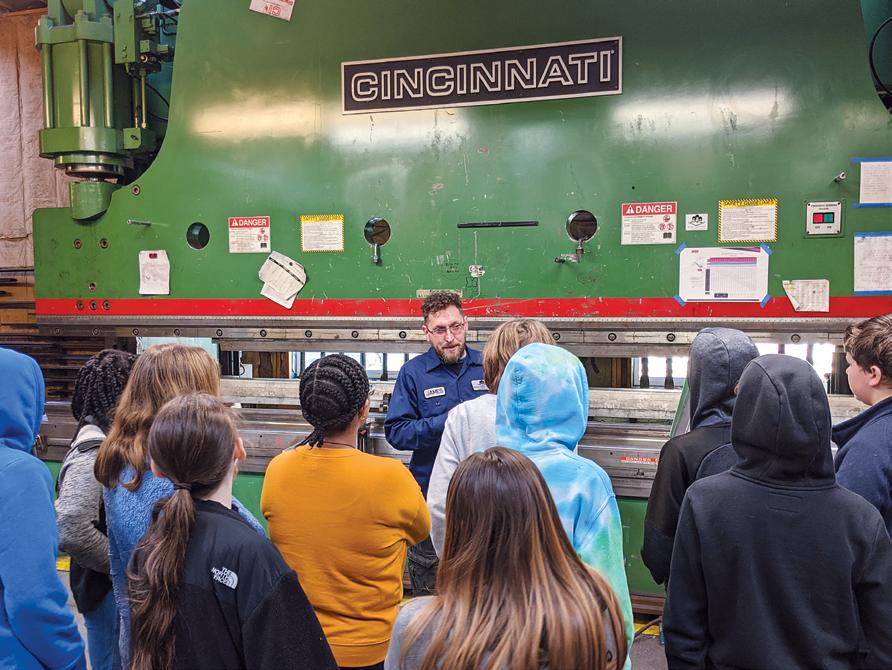
3 minute read
Innovations Task Force
Innovation Task Force: Computational Thinking, Artificial Intelligence, Entrepreneurship, and Financial Literacy
LYSIE TAYLOR, DEAN OF INNOVATIONS & CATHERINE ALLCHIN, (JULIAN ’21), BOARD TRUSTEE
SAAS alum James Reinhardt ’99 and visiting Middle School students at this Pacific Sheet Metal custom metal shop.
Drone operator. AI programmer. Scrum Master. Driverless car engineer. Ten years ago, would you have envisioned these job titles? The early 21st century is one of the most transformational times in human history. Consider that today Facebook is available in 101 languages, and there are more than 500 million Tweets a day on Twitter. The number of texts sent and received every day exceeds the total population of the planet. We are living in exponential times.
Most children in elementary school today will end up working in completely new jobs that don’t exist yet, according to the World Economic Forum. Chances are, they will work more different jobs in their lifetimes than their ancestors did. Longer life expectancies mean longer work lives. How do schools like Seattle Academy prepare students for a workforce—and for a world—that we can’t predict?
Faculty and administration have been grappling with that question for the past several years. For the 2018–2019 school year, we introduced not only the new eight-block schedule but also new graduation requirements in areas like Innovations, Entrepreneurship, Computational Thinking, Artificial Intelligence, and Financial Literacy. Requiring these courses alleviates issues of equity and inclusion: all students must take them. By adding these courses, SAAS is building a curriculum to prepare young people for the rapidly changing world.
However, for many high schools, these areas of study are entirely new. The topics are the Wild West of academia, a new frontier of learning. To help us navigate this new territory, we have consulted with industry experts—alumni, parents, and community leaders—to better understand the market needs and identify new angles for teaching that will be relevant for all stages of life. Last year, the Board of Trustees formed “new initiative” advisory councils, made up of professionals who volunteer their time and talent to advise on the expansion of our new programs.
The partnership has yielded invaluable input. Many of the group members have joined classrooms as guest speakers and invited students to their places of business. SAAS gained a new faculty member, our resident entrepreneur and alumna, Mariah Gentry ‘09. Parent and alumni industry leaders have encouraged us to focus on student tinkering, failing, asking questions, being curious. In Computational Thinking, for example, we’ve heard that students must understand the logic behind the code before they learn to code. This type of thinking, we believe, will be required in all fields, not just programming. In Financial Literacy, we’ve talked about credit card use, digital privacy, taxes, and college debt. We are teaching the fundamentals before students dive into complex decision-making.
IN THE INNOVATIONS 10 COURSE, TOM FLOOD, ALONG WITH THE SCHOOL COUNSELORS, GUIDES STUDENTS THROUGH “RESILIENCE TRAINING,” WHERE THEY TALK ABOUT HOW THEY LEARN FROM FAILURE AND USE IT TO IMPROVE.
A couple of recurring themes have resonated in our conversations. First, ethics. This would include not only the ethics of artificial intelligence, but the ethics of running a business and the importance of social entrepreneurship. For example, after creating a facial recognition program in Software Development, students discussed the real-world implications of bias in datasets and personal privacy.
Second, empathy. Many professionals have told us that they have an easy time hiring people who have the hard skills like mastery of Excel and Slack, but they are yearning for prospective employees who possess the soft skills of teamwork, creativity, and empathy. We’re trying to build those character-based skills into our curriculum. For example, a recent 7th Grade Innovations assignment was to create a circuitry project with an LED light. The kicker: it needed to help someone other than yourself. Student ideas included an ice pack for a mom’s knee, a ramp for an old dog, and a book light for a grandparent who loves










